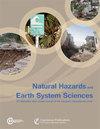2016年新西兰7.8级Kaikōura地震期间沿海地震引发的滑坡易感性
IF 4.7
2区 地球科学
Q1 GEOSCIENCES, MULTIDISCIPLINARY
引用次数: 0
摘要
摘要沿海的山坡通常比内陆的山坡更容易发生地震引发的山体滑坡,但很少有研究调查这种情况发生的原因。结果表明,主要在内陆山坡上建立的区域地震诱发滑坡易感性模型是否是海岸敏感性的有效预测因子。2016年新西兰东南南岛凯库拉7.8级地震导致约1600处山体滑坡 > 50 斜坡上的m2 > 15∘在1之内 海岸公里,造成的滑坡源区密度比1至3范围内的内陆山坡高一个数量级 海岸公里。在这项研究中,使用逻辑回归模型来调查沿海和内陆山坡的滑坡易感性如何不同,并确定驱动2016年凯库拉地震引发的沿海滑坡分布的因素。在采用四种简化地质类型的八个模型中观察到了强大的模型性能(接收算子特征曲线下面积或AUC约为0.80至0.92)。同样的滑坡易感因素,主要是地质、陡坡和地面运动,是Kaikōura地区内陆和沿海易感性的有力模型预测因素。在三种地质类型中(占90%以上 % 在使用内陆训练模型预测海岸滑坡时,观察到模型AUC下降0.03或更小。这表明Kaikōura地区内陆和沿海滑坡易感性特征之间几乎没有差异。内陆和沿海山坡之间的地质分布相似,沿海山坡的绕峰加速度(PGA)通常较低。然而,沿海山坡的坡度角明显更高,这为2016年Kaikōura地震期间沿海山体滑坡的高密度提供了最好的解释。现有的区域地震诱发的滑坡易感性模型使用共同的预测特征在内陆山坡上训练,很可能在没有额外预测变量的情况下捕捉到这一信号。有趣的是,在Kaikōura地区,大多数海岸山坡都被隆起的海岸平台与海洋隔离。这次事件增强了海岸滑坡的易感性,这似乎是过去波浪作用侵蚀的遗留影响,波浪作用优先使这些海岸山坡变陡。本文章由计算机程序翻译,如有差异,请以英文原文为准。
Coastal earthquake-induced landslide susceptibility during the 2016 Mw 7.8 Kaikōura earthquake, New Zealand
Abstract. Coastal hillslopes often host higher concentrations of
earthquake-induced landslides than those further inland, but few studies
have investigated the reasons for this occurrence. As a result, it is
unclear if regional earthquake-induced landslide susceptibility models
trained primarily on inland hillslopes are effective predictors of coastal
susceptibility. The 2016 Mw 7.8 Kaikōura earthquake on the
northeastern South Island of New Zealand resulted in ca. 1600 landslides > 50 m2 on slopes > 15∘ within 1 km of
the coast, contributing to an order of magnitude greater landslide source
area density than inland hillslopes within 1 to 3 km of the coast. In this
study, logistic regression modelling is used to investigate how landslide
susceptibility differs between coastal and inland hillslopes and to determine
the factors that drive the distribution of coastal landslides initiated by
the 2016 Kaikōura earthquake. Strong model performance (area under the
receiver operator characteristic curve or AUC of ca. 0.80 to 0.92) was
observed across eight models, which adopt four simplified geology types. The
same landslide susceptibility factors, primarily geology, steep slopes, and
ground motion, are strong model predictors for both inland and coastal
landslide susceptibility in the Kaikōura region. In three geology types
(which account for more than 90 % of landslide source areas), a 0.03 or
less drop in model AUC is observed when predicting coastal landslides using
inland-trained models. This suggests little difference between the features
driving inland and coastal landslide susceptibility in the Kaikōura
region. Geology is similarly distributed between inland and coastal
hillslopes, and peak
ground acceleration (PGA) is generally lower in coastal hillslopes. Slope angle,
however, is significantly higher in coastal hillslopes and provides the best
explanation for the high density of coastal landslides during the 2016
Kaikōura earthquake. Existing regional earthquake-induced landslide
susceptibility models trained on inland hillslopes using common predictive
features are likely to capture this signal without additional predictive
variables. Interestingly, in the Kaikōura region, most coastal
hillslopes are isolated from the ocean by uplifted shore platforms. Enhanced
coastal landslide susceptibility from this event appears to be a legacy
effect of past erosion from wave action, which preferentially steepened
these coastal hillslopes.
求助全文
通过发布文献求助,成功后即可免费获取论文全文。
去求助
来源期刊
CiteScore
7.60
自引率
6.50%
发文量
192
审稿时长
3.8 months
期刊介绍:
Natural Hazards and Earth System Sciences (NHESS) is an interdisciplinary and international journal dedicated to the public discussion and open-access publication of high-quality studies and original research on natural hazards and their consequences. Embracing a holistic Earth system science approach, NHESS serves a wide and diverse community of research scientists, practitioners, and decision makers concerned with detection of natural hazards, monitoring and modelling, vulnerability and risk assessment, and the design and implementation of mitigation and adaptation strategies, including economical, societal, and educational aspects.

 求助内容:
求助内容: 应助结果提醒方式:
应助结果提醒方式:


